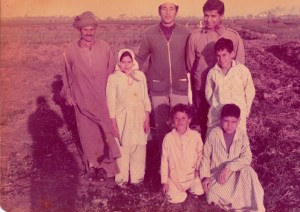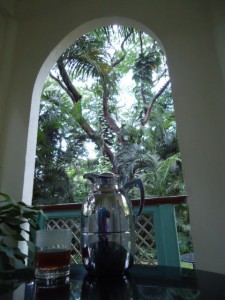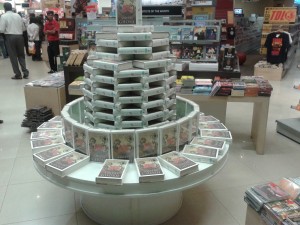My visit to Bangalore began propitiously with an excellent dinner at the home of Shoba Narayan, whose books and articles I have been following for a long time: she is without a doubt one of the best food writers in the country. But my luck didn’t last: scarcely had I settled into my hotel room than I was struck down by Bangalore’s infamous allergens. Reduced to a state of groggy hoarsness, I thought I would not be able attend any of the many events that had been organized for River of Smoke.
But on learning of my condition a concerned friend caused magically to appear in my hotel room, a flask of a miraculous elixir called kashayam.
This potion was so delicious, and so soothing, that I drank copious amounts of it. Sure enough my voice was restored and I was able to carry on which was a fortunate thing since the bookstores
had taken a great deal of trouble over the events.
Afterwards, determined to obtain a recipe, I called the hotel’s kitchen. The chefs were nonplussed: kashayam is something they make on autopilot, as it were, not by adhering to a recipe. All they could tell me was that it is made by boiling together, in a pot, with an unspecified amount of water, the following ingredients: ginger, cardamom, jaggery, coriander seeds, mint leaves and black pepper. After the resulting broth is strained, some honey and a small amount of filtered coffee is added to it.
Since then I’ve found several recipes for kashayam on the Net (I was interested to find that some of the people who’d commented on the recipes had been drinking kashayam since they were children, and their memories of it were by no means as happy as mine!). The ingredients are mostly the same, but one recipe includes ajwain (carom seeds) and jeera (cumin) and recommends toasting the spices before boiling, which makes sense. Another offers a more complicated list of ingredients, including galangal and liquorice. The addition of the coffee appears to be an innovation particular to the West End Hotel – I saw no mention of it anywhere else.
I felt doubly beholden to the restorative powers of kashayam when a chance phone call led to a meeting with two enthusiastic readers – Vikram Kirloskar and his charming and talented daughter Manasi.
Vikram is an MIT-trained engineer and Manasi is studying painting at the Rhode Island School of Design in the US. They are members of the industrial family that now manufactures cars in India, in co-operation with Toyota.
But for me the name Kirloskar will forever be identified with a different kind of product – water pumps.
In 1980, when I went to live in rural Egypt,

I discovered, somewhat to my astonishment, that the pumps used in the fields were all ‘Kirloskar’ machines, manufactured in India. To the villagers al-Hind (India) meant two things: Bollywood films and Kirloskar pumps. I have written about this elsewhere:
‘The other principal association that rural Egypt had with India, was the matter of water-pumps, which were of course very important in rural communities. In those days Egypt imported so many water pumps from India that in some areas these machines were known as makana Hindi – or simply as Kirloskar, from the name of a major pump-manufacturing company. The purchasing of a water pump was a great event, and the machine would be brought back on a pick-up truck, with much fanfare, with strings of old shoes strung around the spout to ward off the Evil Eye. Long before the machine made its entry into the village, a posse of children would be sent to summon me: as an Indian I was expected to be an expert on these machines, and the proud new owners would wait anxiously for me to pronounce on the virtues and failings of their new acquisition.
‘Now it so happens that I am one of those people who is hard put to tell a spanner from a hammer or a sprocket from a gasket. At first I protested vigorously, disclaiming all knowledge of machinery. But here again, no one believed me; they thought I was witholding vital information or playing some kind of deep and devious game. Often people would look crestfallen, imagining, no doubt, that I had detected a fatal flaw in their machine and was refusing to divulge the details. This would not do of course, and in order to set everyone’s fears at rest, I became, willy-nilly, an oracle of water-pumps. I developed a little routine, where I would subject the machine to a minute inspection, occasionally tapping it with my knuckles or poking it with my fingers. Fortunately no machine failed my inspection: at the end of it I would invariably pronounce the water-pump to be a makana mumtaaza – a most excellent Kirloskar, a truly distinguished member of its species.’
To meet Kirloskars in the flesh – and two such interesting and well-read members of the family at that – was wholly unforeseen: I reckoned that Bangalore had compensated me more than fairly for my onslaught of allergies





kashayam basically means a herbal concoction, and there are variants for specific ailments/allergies – the pepper-ginger for cold/cough, the ajwain/jeera/coriander one for heat/indigestion etc. I never heard of the coffee addition either